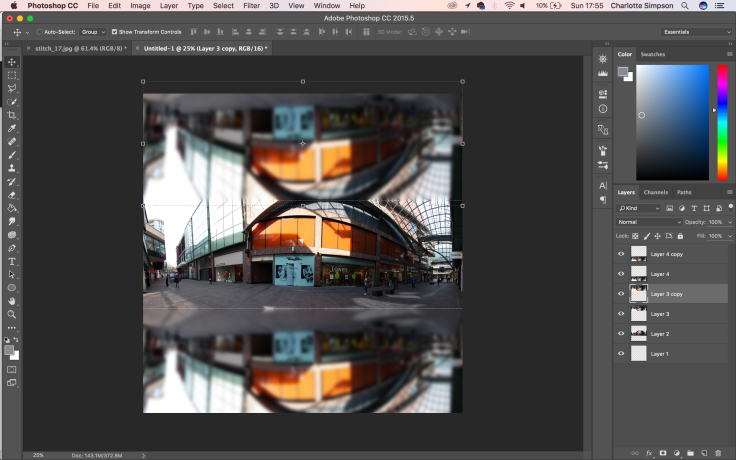- Concerned with visibility/spectator
- Participatory media…
*Visuality:
- Core element of cinema
- Core element of immersion?
- Touch, Visceral Responses –> Mirror Neurons, embodied responses, empathy
- Status Quo of being seen?
*Do our bodies respond initially before our minds, are our embodies responses faster than our cognitions?
- Attention capturing media, Interactive and Social
- Computerisation is Changing how our attention is used… See Johnathan Crary
- Dynamic media, technology moves from phases of being open access to being institutionalised and state governed?
- Affordances: What does technology allow/enable us to do?
- Community of practitioners that use resources in innovative ways, making individual stories visible [Relatable and Immersive?]
- Presence = Optical illusion of presence isn’t an illusion of moment [VR is an illusion of presence, becoming an actor within that virtual space]
- Testimony -> Visceral responses linked to power of testimony (E.g. Hunger in LA)
- Machine to another, Immersive and emotional, empathetic responses – drawing on basic and innate emotional responses such as protection, kinship and relatability.
- A virtual and Simulated presence that lead to a physical and embodies emotional response… [What is empathy and how does this affect us? Ethical, Moral, Safe Guarding considerations?]
- Increased emphasis on personalised media as a means to immerse audience members… [Data Harvesting, Uses? Limits? Affordances? Exploitation or Empowerment? Ethical and Moral Considerations?] (e.g. DONOTTRACK, DigitalMe, YouAreWhatYouLike etc.)
Museum & Heritage Industries:
- Bottom-up Approach to media? How do we fragment authority? Where does the ‘truth’ actually come from?
- Do museums belong to everybody or the elite few? Do they exist to serve the public? Do they Enhance publics and cultures?
- Curator is no longer solely responsible for content, now become a wider system with public, social, educational and economic influence
- ‘Cultural Identity’ as part of one’s heritage, social and educational memory
Museums in the real world…
Concerns / upkeep:
- Footfall, Dwell Time, Secondary Time –> careful planning, analysis and investment into the future of cultural heritage industries
- Audience Segmentation, how do we reach most if not all member of the public? Appeal to specific and targeted groups, traditional and hard to reach minorities… Spirit of Place Statements
- Has to achieve a delicate balance between appealing to both traditional/frequent users (as to not alienate) whilst also continuing to appeal to wider and more difficult users –> delicate balance between social, education, entertainment and economics in order to sustain…
- Currently entering an awkward phase by attempting to maintain current and future demographics (Tech or No Tech? What is too much? Where are the boundaries between Education and Entertainment?
- REJECT PASSIVITY! -> Provacation
Immersive Heritage Technologies:
- Gamification of education and learning? Apps, Websites, Games, Exercises [Does this enhance or detract from experiences and learning?]
Immersive Heritage: http://www.immersiveheritage.com/
Wonder [360-Degree Immersion]: http://renwick.americanart.si.edu/wonder
“The Immersive Cultural Museum Experience – Creating Context and Story with New Media Technology” Maggie Burnette Stogner, American University, USA: http://www.ce3c.com/emotion/wp-content/uploads/2013/09/immserive-cculture.pdf
Soluis: http://www.soluis.com/heritage/
Museum Exercise:
My First Attempt at VR media…

Here, I quickly knocked up some a Panoramic/VR image using some open-source coding and Panoramic images stitches from last years coursework… I am really happy with the overall result! I have tested this on both my Laptop, Phone and VR headset, it is working well! In the future I will attempt to shoot with a wider space, focusing on top and bottom of the screen also. I feel that from my experience the most immersive method is the VR headset, due to you having to physically wear it on your head, it creates quite an intimate atmosphere which seems immersive and personal.
VR Test 1:
//storage.googleapis.com/vrview/index.html?image=//i.imgur.com/ZpfDVy6.jpg&%20is_stereo=true
VR Test 2:
References:
Poole, S. (2017) ‘Mobile Experience Design for Adventure Heritage’. Media Culture 2. [Online] Available from: https://my.uwe.ac.uk [Accessed 3oth January 2017]
Swanson, G. (2017) Museum Media. Media Culture 2. [Online] Available from: https://my.uwe.ac.uk [Accessed 3oth January 2017]
Henning, M. (2011) ‘New Media’, in Sharon McDonald (ed) A Companion to Museum Studies. London: Blackwell, pp302-306
Kidd, J. (2014) ‘Introduction: On Museum Media’ in Museums in the New Mediascape: Transmedia, Participation, Ethics. London: Ashgate. pp. 1-10
Immersive Heritage Pty Ltd (2017) Immersive Heritage. Available from: http://www.immersiveheritage.com/ [Accessed 30th January 2017]
Smithsonian American Art Museum (2017) WONDER. Available from: http://renwick.americanart.si.edu/wonder [Accessed 30th January 2017]
Burnette Stogner, M. (2011) “The Immersive Cultural Museum Experience – Creating Context and Story with New Media Technology”. The International Journal of the Inclusive Museum. [Online] Vol. 3 (3) pp 117-130.
Soluis Group Ltd (2015) Heritage Visualization. Available from: http://www.soluis.com/heritage/ [Accessed 30th January 2017]
Catanzariti, P. (2016) Embedding Virtual Reality Across the Web with VR Views. Available from: https://www.sitepoint.com/embedding-virtual-reality-across-the-web-with-vr-views/ [Accessed 12 February 2017]
Google (2017) Embedding VR view. Available from: https://developers.google.com/vr/concepts/vrview [Accessed 12 February 2017]



Leave a comment